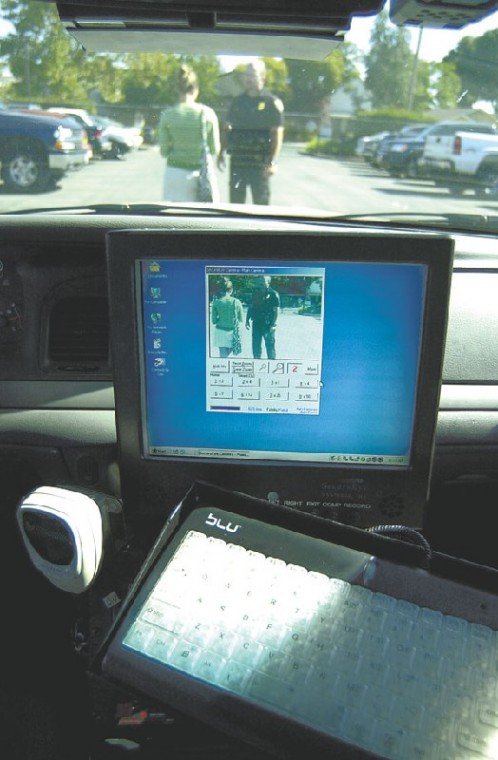Gilroy adds satellite-direct computers, cameras to patrol
cars
Gilroy – A new computer system in Gilroy police vehicles is improving emergency response times and giving officers almost instantaneous access to information.
Since March, the Gilroy Police Department has installed Mobile Data Computers (MDCs) in about 32 squad cars, a technological jump forward from their old system of relying on dispatcher reports and video cassettes.
Now, digital cameras hang next to the rearview mirror and a laptop computer is fastened beside the driver’s seat. The camera can zoom in so close that the grout between bricks fifteen feet away is visible.
“Anything that I can run through a dispatcher, I can do here,” said Sgt. Kurt Svardal, pointing to the computer screen.
A grid shows what each car logged onto the system is doing. The Gilroy Fire Department is linked to the program as well.
At 9:24am Wednesday, as GFD responded to a medical aid call, GPD officers were attending to an active alarm. Neighborhoods away, another squad car was responding to a complaint of a barking dog.
By touching the screen, officers can get more specific information on a particular call. A closer look reveals that the medical aid situation is a patient experiencing chest pains.
MDCs allow officers to see what is occurring in town and make some reports from the field. The system is connected to both the California Law Enforcement Telecommunications System and the National Crime Information Center. Therefore if an officer is running a license plate scan on a car from Iowa, and the vehicle is associated with a kidnapping – the information will pop up onto the officer’s screen.
“Before we had these, I would have to come back to the station and enter the information into the system,” Svardal said, explaining how the entire $684,559 system has increased efficiency.
On Friday and Saturday nights when there is a high level of radio traffic, oftentimes officers in the field need to wait for dispatchers to be available to run scans, taking 10 to 15 minutes, Svardal said.
Rather than rely on dispatchers and clog the radio, officers can run driver’s license and plate scans from their car – and results are almost instantaneous.
As Svardal entered a name and date of birth into the computer, a split second after he pressed return, five results were returned: The person was not wanted for arrest.
Before MDCs were used, GPD only had a video camera in police vehicles. The old system cost about $3,000 to $4,000 per car.
Gilroy City Council awarded the contract for MDCs last year.
“In the old system we always had to change videotapes. Now it’s completely digital,” Svardal said.
Police are required to keep tapes for various periods of time if lawsuits are pending or depending upon the extent of the crime captured. Storing a CD-ROM disc is more economical than a videotape.
As long as the car is on, the cameras are recording. Theoretically, because officers do not have to switch tapes – they should not miss anything. However, the computers use a satellite feed and are susceptible to technological failures. But they have not experienced any problems so far.
MDCs have an additional benefit: They give directions.
“When I first started, you knew the whole town,” Svardal said. “No more, it’s too big.”
Now, officers can request directions and they appear on the screen. There is no more scrambling to write information down.
When Investigator Joseph Deras worked in San Jose Police Department, he used the same system. He came to Gilroy in 2003 and said since the installation of MDCs, response times have improved.
“It makes us more accessible,” he said. “The response times to emergencies are much better because (officers) are closer.”
While police have used video cameras in squad cars for years, the digital cameras have a much crisper view. A license plate can be viewed clearly from down the block.
There is an added benefit to using the digital cameras: Whatever is caught on camera can be played back from the car and by supervisors at the station. The information can be used in court to show what events actually took place in an arrest.
Officers have used such tapes nationwide to clear their names when the individual arrested made false claims against them.
“Supervisors can review (tapes) for integrity purposes – if someone has a complaint,” Deras said. “It can memorialize what happened.”














